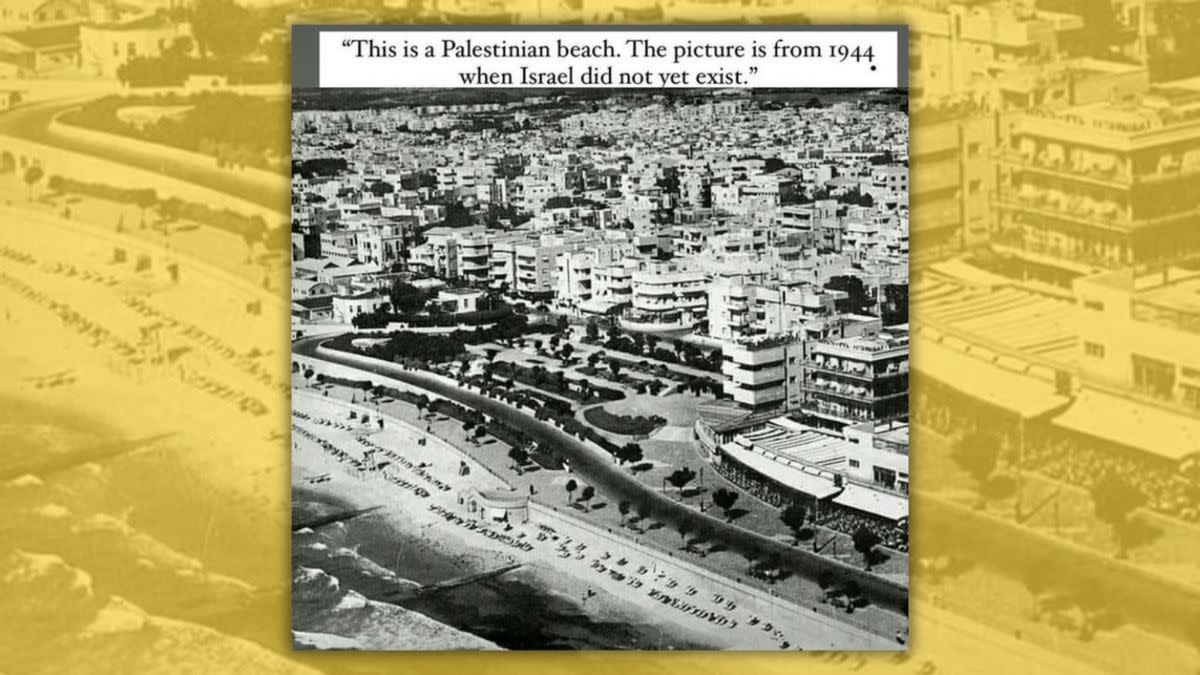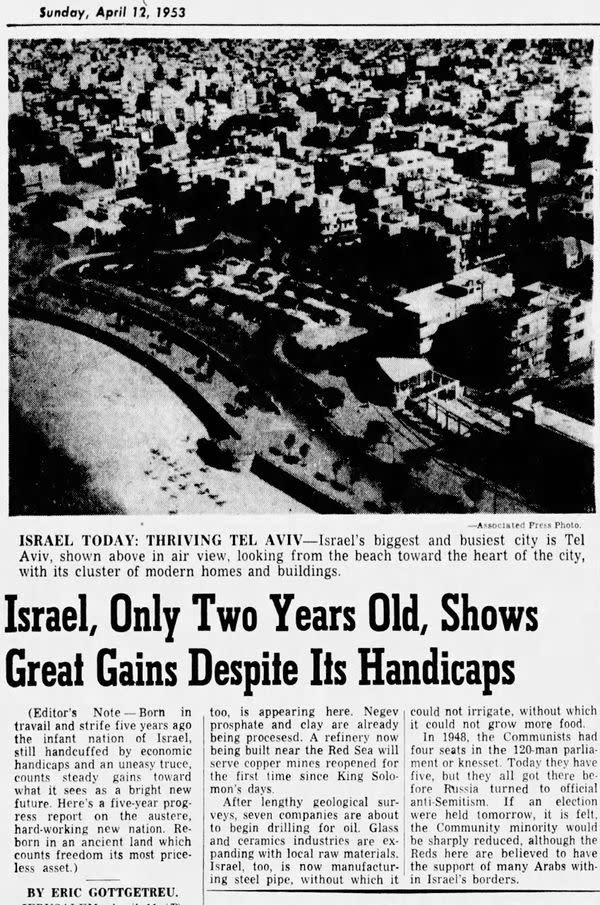The History Behind Pic Allegedly Showing a Palestinian Beach Before Israel Was Founded

The protracted, often bloody Israeli-Palestinian conflict exploded into a hot war on Oct. 7, 2023, when the militant Palestinian group Hamas launched a deadly attack on Israel and Israel retaliated by bombarding the Gaza Strip. More than 20,000 people, the vast majority of them Palestinians, were reportedly killed during the first two months of the war alone. The violence is driven by mutual hostilities and territorial ambitions dating back more than a century. The internet has become an unofficial front in that war and is rife with misinformation, which Snopes is dedicated to countering with facts and context. You can help. Read the latest fact checks. Submit questionable claims. Become a Snopes Member to support our work. We welcome your participation and feedback.
As the Israel-Hamas war continued, a photograph lapped social media with captions claiming (archived) it depicted Palestine before Zionism and the foundation of Israel (archived):
Palestine in 1944
Before the incursion of the Zionism virus pic.twitter.com/wyw0OpmtmC— 𝑴𝒊𝒒𝒅𝒂𝒂𝒅 🇵🇸 (@Miqdaad_hussein) June 21, 2024
(archived)
For example, a December 2023 post on X with the claim gained 5.7 million views, 17,600 likes and more than 6,500 shares. Many similar posts surfaced months later, in June 2024. The image existed on other platforms, too, including Reddit, where it included the tag "imperialism" and was upvoted 5,200 times, and Instagram.
What Year Was the Photograph Taken?
The photograph is difficult to date. A reverse-image search using TinEye and Google brought up several references for this image, all of which confirm it is an aerial view of a portion of the Tel Aviv Promenade. Tel Aviv is Israel's second-largest city.
One of the references is the catalog of a 2013 exhibit "White City: Bauhaus Architecture in Tel Aviv" at the Hermitage Museum in St Petersburg, Russia.
Another is a 2013 blog post, which includes the photograph of a 2002 book titled "Bauhaus Tel Aviv," by Nahoum Cohen. The blog post dates the photograph to 1940, presumably citing the book.
We located a very similar image — though not the same one — on the eBay page of an antique and vintage photograph dealer. The product detail page titled it "Epic Aerial View of HISTORIC City of TEL AVIV Israel VINTAGE 1953 Press Photo." It includes a photo of the back of the photograph, which reads as follows:
B16324
WIDE WORLD
PLEASE CREDIT
(For use Sunday, April 12, with Eric Gottgetreu's Jerusalem AP-N story on Israel's 5th anniversary.)ISRAEL TODAY: THRIVING TEL AVIV
Israel's biggest and busiest city is Tel Aviv, shown above in airview, looking from the beach towards the heart of the city with its cluster of modern homes and buildings. Combined with adjacent Jaffa, the city has a population of 400,000. Near Tel Aviv is the big international aerodrome LOD (Lydda), home of Israel's national airline, "El Al."5392 1135A- 4/3/53 AJE F WAB165
There is a stamp in purple ink on this text that says "RECEIVED EXAMINER REFERENCE LIBRARY APR 12 1953."
This photograph shows a less-built-up landscape, smaller trees and few people on the beach, indicating that it might have been taken earlier than the photograph in the viral posts.
Still, we used this information in a search on newspapers.com, a site that compiles newspaper archives, and we found several references to articles that published this photograph on April 12, 1953, and days later — using Gottgetreu's article and a portion or all of the caption cited above. This one is from the Fort Worth Star-Telegram (note the headline is incorrect: in 1953, Israel had existed for five years, not two):

(newspaper.com)
Unfortunately, even this date and stamp cannot guarantee that the photo was taken in 1953, as press practices regarding image use were not as rigorous at the time as they can be in the 21st century. Not to mention, a deep dive into the history of Tel Aviv confirms that this beachfront was most likely constructed in the 1930s.
But the landscape seen in the photograph could not have been built before 1941, because it clearly shows London Square on Bugrashov Beach in Central Tel Aviv, which was inaugurated in 1942 — a year after the end of Germany's bombing campaign against the United Kingdom known as the Blitz. This dates the photograph between 1942 and 1953.
Bauhaus and Tel Aviv
As soon as Adolf Hitler was elected Germany's chancellor in 1933, thousands of Jews left Germany for Mandatory Palestine. The wave of emigration intensified in 1935, when the Nuremberg race laws — which deprived Germany's Jews of rights — took effect. It continued until 1939, when Hitler invaded Poland, and France and the United Kingdom declared war. In 1941, Hitler decided that instead of encouraging Jewish emigration from Europe, he would focus on exterminating Jews.
Hitler's rise to power also caused the closure of the Bauhaus art school in 1933. According to journalist and Pulitzer Center grantee Verónica Zaragovia, the Nazis were hostile to the Bauhaus "because it was avant-garde and utopian. Because some of its members had ties to the Soviet Union or to communists, others were Jewish." This led at least half its students and professors to leave Germany, but instead of marking the end of the Bauhaus movement, it led to its revival elsewhere in the world — notably in Tel Aviv.
In the 1930s, Tel Aviv was in the middle of a construction boom. Founded by Jews under Ottoman rule in 1906, its first name was Ahuzat Bayit ("homestead" in Hebrew). To get around laws that banned land sales to Jewish subjects of the Ottoman empire, a Jewish banker named Jacobus Kann used his Dutch citizenship to buy the first 60 plots in his name.
Tel Aviv's construction started in earnest in the 1920s, and it accelerated in the 1930s with the arrival of Jewish German émigrés. The timing contributed to turning Tel Aviv into a gem of Bauhaus architecture. Zaragovia wrote:
The students and teachers who left spread Bauhaus designs and helped it flourish around the world including the U.S. and Israel. Like in Tel Aviv — a city I lived in for about a year after college. About 4,000 Bauhaus-influenced buildings — designed by Jewish architects, some who'd studied at the Bauhaus — dot the city. They have flat roofs, balconies and simple straight or curvy lines.
The more than 4,000 buildings, built in the 1930s, became collectively known as the White City. The White City was inscribed as a protected site at the UNESCO World Heritage Center in 2003 (see the map of the conservation areas). Architecture Digest published an article in 2019 featuring some of Tel Aviv's best examples of this architecture.
In sum, the photograph is a snapshot of the early days of Tel Aviv. Though founded under Ottoman rule, it was built out during the British Mandate of Palestine by a growing community of Jews. In other words, this was a city created by the Zionist movement before the foundation of Israel.
In 2023, Snopes researched whether a different photo showed a street in Jerusalem before the founding of Israel.
Sources:
'10 of Tel Aviv's Best Examples of Bauhaus Architecture'. Dezeen, 24 Aug. 2016, https://www.dezeen.com/2016/08/24/10-tel-aviv-best-examples-bauhaus-residential-architecture/.
'12 Apr 1953, Page 19 - Fort Worth Star-Telegram at Newspapers.Com'. Newspapers.Com, https://www.newspapers.com/image/636730570/. Accessed 17 Apr. 2024.
'100 Years of the Bauhaus'. @GI_weltweit, https://www.goethe.de/prj/tbp/en/bpa/yea.html. Accessed 17 Apr. 2024.
Azoulay, Yuval. 'Jacobus Street, Corner of Oblivion'. Haaretz, 1 Apr. 2009, https://web.archive.org/web/20120404193456/http://www.haaretz.com/print-edition/features/jacobus-street-corner-of-oblivion-1.273311.
Centre, UNESCO World Heritage. 'White City of Tel-Aviv – the Modern Movement'. UNESCO World Heritage Centre, https://whc.unesco.org/en/list/1096/. Accessed 17 Apr. 2024.
Cohen, Alina. 'Emerging Painter Kira Maria Shewfelt Transforms Moments of Passion into Surreal Canvases'. Artsy, 16 Apr. 2024, https://www.artsy.net/article/artsy-editorial-emerging-painter-kira-maria-shewfelt-transforms-moments-passion-surreal-canvases.
Emigration, 1933-1941 – The Holocaust Explained: Designed for Schools. 4 Jan. 1933, https://www.theholocaustexplained.org/resistance-responses-collaboration/responses/emigration/.
Warkentin, Elizabeth. 'How Did Tel Aviv Become a Beacon For Stunning Bauhaus Architecture?' Architectural Digest, 25 Sept. 2019, https://www.architecturaldigest.com/story/how-did-tel-aviv-become-beacon-stunning-bauhaus-architecture.

